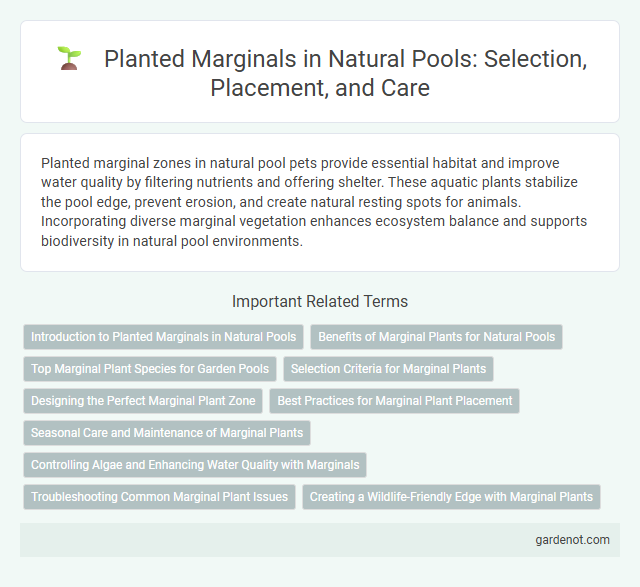Planted marginal zones in natural pool pets provide essential habitat and improve water quality by filtering nutrients and offering shelter. These aquatic plants stabilize the pool edge, prevent erosion, and create natural resting spots for animals. Incorporating diverse marginal vegetation enhances ecosystem balance and supports biodiversity in natural pool environments.
Introduction to Planted Marginals in Natural Pools
Planted marginals in natural pools serve as essential filtration zones where specialized aquatic plants absorb nutrients, reducing algae growth and improving water clarity. These zones mimic natural wetland environments, promoting biodiversity by providing habitat for beneficial microorganisms and insects. Strategically positioned around the pool edges, planted marginals enhance both the ecological balance and aesthetic appeal of natural swimming habitats.
Benefits of Marginal Plants for Natural Pools
Marginal plants in natural pools play a crucial role in maintaining water quality by filtering pollutants and absorbing excess nutrients, which reduces algae growth. These plants create a natural habitat for beneficial microorganisms and aquatic wildlife, promoting biodiversity and ecological balance. Their root systems stabilize pool edges, preventing erosion while enhancing the aesthetic appeal of the natural swimming environment.
Top Marginal Plant Species for Garden Pools
Top marginal plant species for garden pools include Water Iris (Iris pseudacorus), Pickerelweed (Pontederia cordata), and Cattails (Typha latifolia), which thrive in shallow water zones and enhance natural filtration. These plants stabilize pool edges, reduce algae growth by shading the water, and provide habitat for beneficial insects and amphibians. Incorporating a diversity of marginal plants supports a balanced aquatic ecosystem and improves the aesthetic appeal of natural pools.
Selection Criteria for Marginal Plants
Selecting marginal plants for natural pools requires focusing on species that thrive in shallow water zones, enhance filtration, and support biodiversity. Key criteria include tolerance to fluctuating water levels, ability to absorb excess nutrients to prevent algae growth, and root structures that stabilize pool margins. Choosing native plants with strong ecological benefits promotes a balanced and sustainable aquatic environment.
Designing the Perfect Marginal Plant Zone
Designing the perfect marginal plant zone involves selecting water-tolerant species that thrive in shallow edges of natural pools, enhancing biodiversity and water quality. Key plants like cattails, irises, and water lilies provide habitat for aquatic life while stabilizing the pool's perimeter against erosion. Incorporating a variety of native marginal plants ensures year-round interest, natural filtration, and an aesthetically pleasing transition between water and land.
Best Practices for Marginal Plant Placement
Planted marginals thrive in shallow water zones between 15-30 cm deep, where they receive ample sunlight essential for photosynthesis and growth. Positioning these plants away from strong currents or wave action reduces root disturbance and sediment erosion, ensuring robust establishment. Using a mix of native species with varying heights promotes biodiversity while stabilizing pool edges and enhancing water filtration naturally.
Seasonal Care and Maintenance of Marginal Plants
Seasonal care and maintenance of planted marginal plants in natural pools involve regular pruning to prevent overgrowth and promote healthy development. Monitoring water levels and nutrient balance supports optimal root oxygenation and reduces algae proliferation during warmer months. Removing dead foliage and replenishing substrate ensures sustained plant vitality and enhances the ecological filtration capacity throughout the year.
Controlling Algae and Enhancing Water Quality with Marginals
Planted marginals in natural pools play a crucial role in controlling algae growth by absorbing excess nutrients that algae thrive on, effectively reducing their proliferation. These aquatic plants act as natural biofilters, enhancing water quality through oxygenation and the removal of pollutants. Incorporating species like water irises and cattails creates a balanced ecosystem, promoting clear, healthy water without chemical intervention.
Troubleshooting Common Marginal Plant Issues
Planted marginal zones in natural pools often face challenges such as algae overgrowth, poor plant establishment, and nutrient imbalances. Addressing these issues involves ensuring proper water circulation, selecting native aquatic plants suited for local conditions, and maintaining balanced nutrient levels to prevent excessive algae growth. Regular inspection and timely removal of decayed plant material also promote healthier marginal vegetation and overall water quality.
Creating a Wildlife-Friendly Edge with Marginal Plants
Planted marginals in natural pools create a wildlife-friendly edge by providing essential habitats for amphibians, insects, and birds. These plants improve water quality through natural filtration, absorbing excess nutrients and stabilizing the pool's banks to prevent erosion. Selecting native species like water mint, marsh marigold, and flag iris enhances biodiversity while maintaining the pool's ecological balance.
Planted marginal Infographic

 gardenot.com
gardenot.com